Stone spiral gardens create stunning, functional boundaries that blend aesthetic appeal with practicality. You’ll enjoy their water-efficient design that reduces irrigation needs by 20% while creating distinct microclimates for diverse plants. Their varying heights provide natural privacy screens and sound barriers, defining your outdoor space with minimal maintenance. The historical significance and visual impact of these living sculptures add value to your property. Discover how these ancient-inspired designs can transform your ordinary garden edges into enchanting focal points.
The History and Evolution of Stone Spiral Gardens
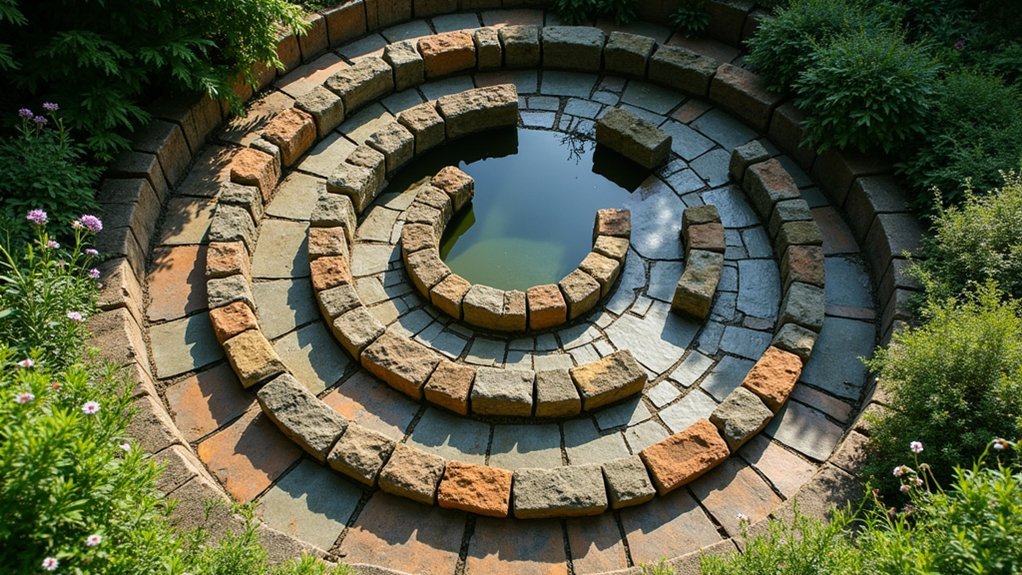
While many gardeners view spirals as merely decorative elements, these intricate stone formations have deep historical and cultural significance spanning thousands of years.
When you create a stone spiral garden, you’re connecting with ancient civilizations that used these symbolic shapes to represent life’s journey and spiritual growth in their sacred spaces.
The early 20th century saw spirals reimagined through the Arts and Crafts movement, which celebrated their organic form and natural materials.
You’ll find this influence in gardens that prioritize handcrafted aesthetics over mass production.
Design Principles for Effective Boundary Spirals
Because they blend form with function, stone spiral gardens excel as landscape boundaries that transcend ordinary dividers.
Stone spiral gardens unite aesthetic appeal with practical purpose, creating boundary solutions that defy conventional separation methods.
When designing your spiral boundary, focus on height variations to create natural shifts between spaces while establishing distinct microclimates for diverse plantings.
Your spiral design should incorporate:
- Varied stone sizes and colors to enhance visual interest and texture, creating a more dynamic boundary that draws the eye
- Gradual elevation changes that avoid harsh lines while clearly delineating separate areas of your landscape
- Strategic stone placement that suppresses weeds and retains moisture, reducing long-term maintenance needs
Selecting the Right Stones for Your Spiral Garden
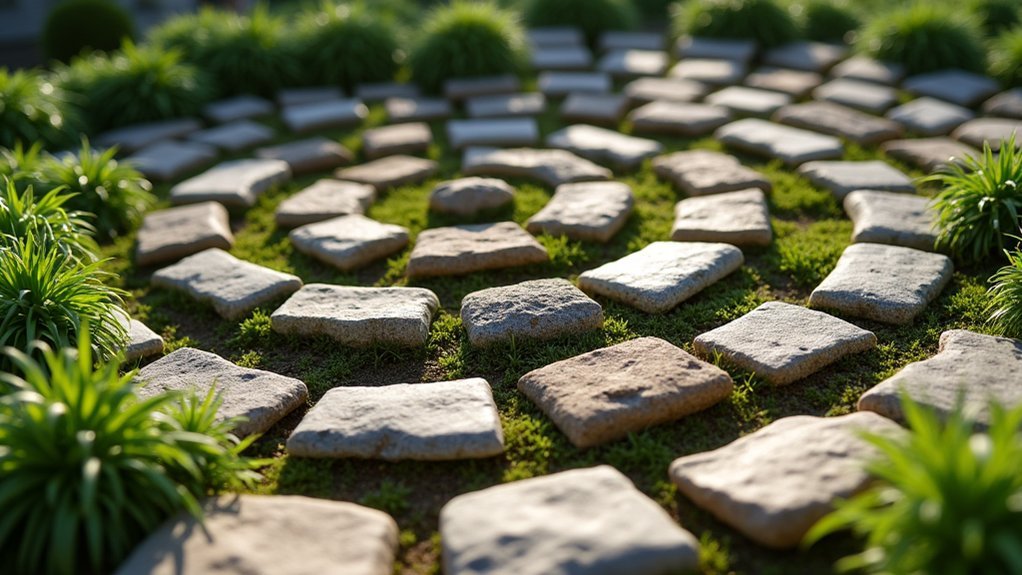
Three important considerations determine the success of your spiral garden boundary: stone variety, placement strategy, and sustainability.
When selecting the right stones for your spiral garden, aim for a diverse mix of sizes—large, medium, and small—to create varying heights and improve drainage in your herb spiral, which should reach about three feet tall for ideal microclimates.
For visual appeal, choose contrasting colors and textures, placing darker stones along the outer layers and lighter ones toward the inner spiral.
Reserve rounded stones for the center to create a softer appearance and enhance water retention. Whenever possible, source stones locally to minimize costs and environmental impact.
Finally, incorporate pavers or bricks at the base to provide vital structural support while clearly defining your garden’s boundaries.
Creating Microclimates Within Your Boundary Spiral
Your stone spiral garden’s height variations naturally create unique temperature zones that support diverse plant communities in a compact space.
You’ll find the top of your spiral receives more sun exposure and heat, perfect for Mediterranean herbs, while the sheltered base maintains cooler, moister conditions ideal for shade-loving varieties.
This natural moisture gradient works with gravity, allowing water to flow downward where you can position thirstier plants, while drought-tolerant species thrive in the well-drained upper sections.
Temperature Variations Maximize Growth
While traditional garden beds offer limited climate control, stone spiral gardens create remarkable temperature differentials that can greatly enhance plant growth.
The spiral’s design naturally generates temperature variations of up to 10°F between different sections, allowing you to grow diverse herbs in a compact space.
Stone’s natural insulation properties work to your advantage, retaining daytime heat during cooler nights and creating protected pockets for sensitive plants.
You’ll maximize your garden’s potential by:
- Placing heat-loving herbs at the sunny, elevated portions
- Utilizing middle sections for plants requiring moderate conditions
- Reserving lower, cooler areas for shade-preferring varieties
Moisture Gradient Benefits Plants
Beyond their aesthetic appeal, stone spiral gardens naturally establish remarkable moisture gradients that transform ordinary boundaries into thriving ecosystems.
You’ll find nearly 20% reduction in water waste compared to traditional flat landscape designs, as water intelligently flows from top to bottom.
The spiral’s varying elevations create distinct microclimates that cater to different plants’ needs.
Position drought-resistant herbs like rosemary and thyme at the top where drainage is excellent, while moisture-loving varieties such as mint and basil thrive in the collected water at the spiral’s base.
Planting Strategies for Herb Spiral Boundaries
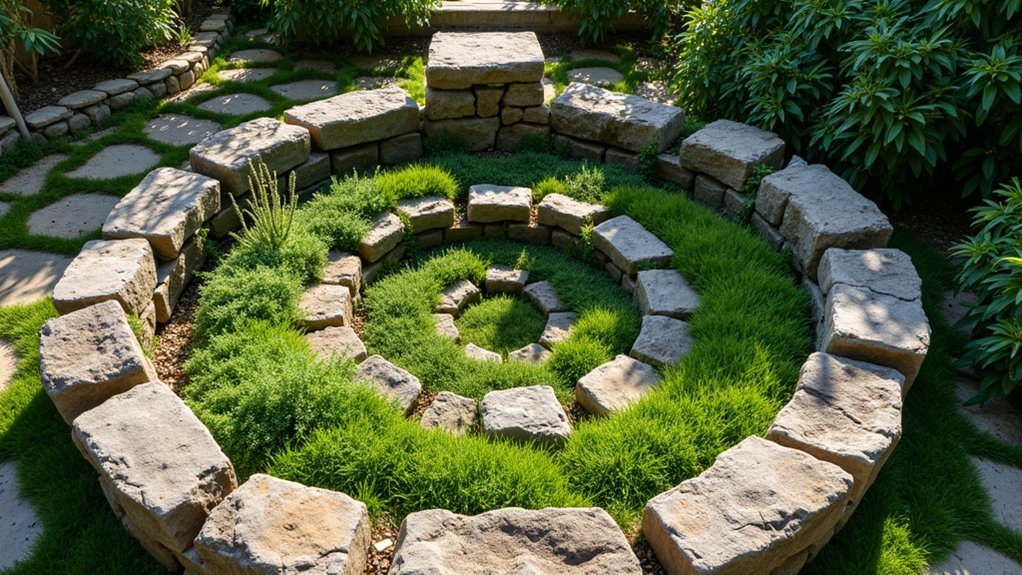
Strategic positioning of herbs within your spiral boundary creates natural shifts from drought-resistant varieties at the top to moisture-loving plants at the bottom.
You’ll maximize your spiral’s effectiveness by incorporating companion plants like marigolds around the edges to repel pests while attracting beneficial insects to your garden ecosystem.
Consider drought-resistant options such as lavender and sage for outer edges where water runoff is minimal, creating a protective and aromatic barrier that defines your garden’s perimeter.
Planting Zone Transitions
As you design your stone spiral garden, understanding how to create effective planting zone shifts becomes essential for maximizing both functionality and beauty.
The elevation changes naturally create microclimates that allow you to shift seamlessly between herbs with different requirements.
Your spiral garden’s shifts should follow the natural water flow from top to bottom:
- Position drought-tolerant Mediterranean herbs like rosemary and thyme at the spiral’s peak where conditions are driest and sunniest.
- Place moderate-moisture herbs such as basil and sage in the middle sections where they’ll receive balanced sun exposure.
- Situate moisture-loving herbs including mint and parsley at the spiral’s base where water collects.
Companion Planting Benefits
With your planting zones carefully arranged, you’ll want to contemplate the relationships between the herbs you select for each area.
Herb spirals offer a unique opportunity to leverage companion planting strategies that enhance growth and productivity.
Pair basil with tomatoes to improve flavor and pest resistance, while strategically placing marigolds throughout your spiral to deter harmful insects and attract pollinators.
Include nitrogen-fixing plants like clover to naturally fertilize the soil for neighboring herbs.
Aromatic herbs such as rosemary and sage serve as natural pesticides, protecting vulnerable plants nearby.
Take advantage of the spiral’s vertical structure by creating multi-layered plantings—taller herbs can provide essential shade for heat-sensitive varieties below.
This diverse ecosystem maximizes your space while creating a self-supporting community of plants that work together.
Drought-Resistant Edge Options
The perimeter of your herb spiral presents an ideal opportunity to incorporate drought-resistant plants that serve both practical and aesthetic purposes.
By choosing lavender, rosemary, and sage for the boundary, you’ll create a vibrant edge that requires minimal watering while adding color and fragrance to your garden.
Adding a layer of stones and gravel around these drought-resistant herbs helps retain moisture in the soil, reducing the need for frequent watering.
For maximum efficiency, apply mulch like wood chips to further decrease evaporation.
- Position taller drought-resistant plants on the outer edge to shade moisture-loving herbs in the spiral’s center.
- Combine succulents with perennials for visual interest with minimal maintenance.
- Create distinct zones using different-sized stones to separate herb varieties while maintaining the spiral aesthetic.
Water Management Benefits of Spiral Stone Structures
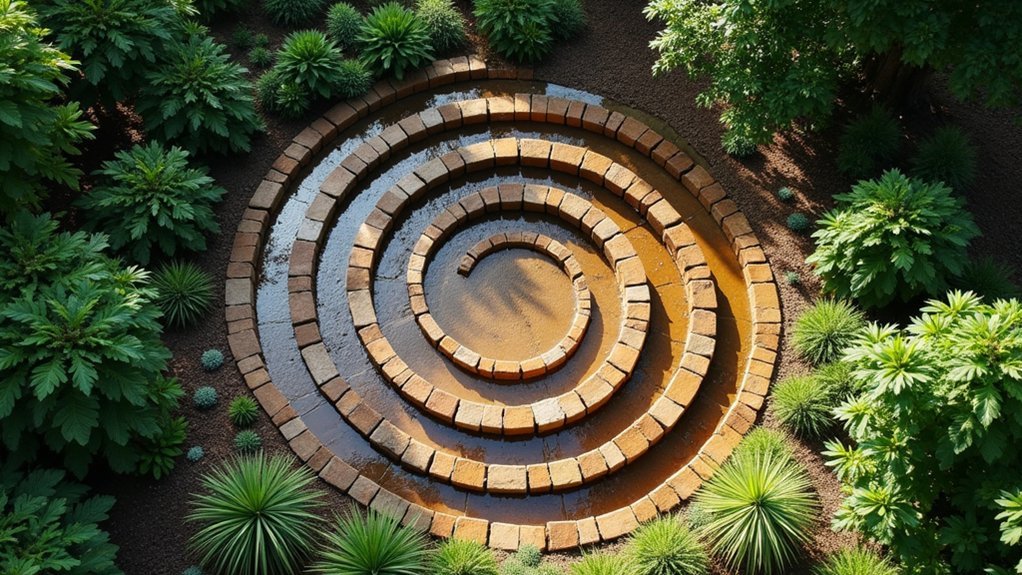
Cleverly designed to harness gravity’s natural power, spiral stone structures offer remarkable water management capabilities that traditional flat gardens simply can’t match.
You’ll save nearly 20% on water usage compared to conventional landscapes, making these spirals an environmentally conscious choice for your boundary.
As water flows downward through your spiral garden, it naturally collects at the base, creating a perfect microclimate for moisture-loving plants.
Meanwhile, drought-resistant varieties thrive at the top where drainage is ideal. This natural stratification prevents waterlogging while ensuring each plant receives precisely what it needs.
For maximum efficiency, consider incorporating drip irrigation into your spiral structure.
This delivers water directly to plant roots, minimizing evaporation and simplifying your maintenance routine while maintaining the water management benefits that make spiral gardens truly exceptional boundary features.
Maintenance Tips for Long-Lasting Stone Boundaries
While stone spiral gardens create striking boundaries with minimal effort, proper maintenance guarantees their longevity for decades to come.
You’ll need to regularly inspect your stone boundaries for shifting or settling, repositioning them as needed to maintain stability and visual appeal.
For easier upkeep and reduced weed intrusion, install weed barrier fabric beneath your stones before construction. This simple step dramatically reduces future maintenance demands.
- Clean stones periodically to remove debris and prevent moss buildup
- Apply landscape fabric or mulch around the base to prevent soil erosion
- Consider sealing porous stones with a quality stone sealer in high-rainfall areas
Periodic attention to these maintenance tasks will preserve both the structural integrity and aesthetic charm of your stone boundaries, ensuring they continue to define your garden’s edge beautifully.
Enhancing Privacy and Security With Spiral Garden Designs
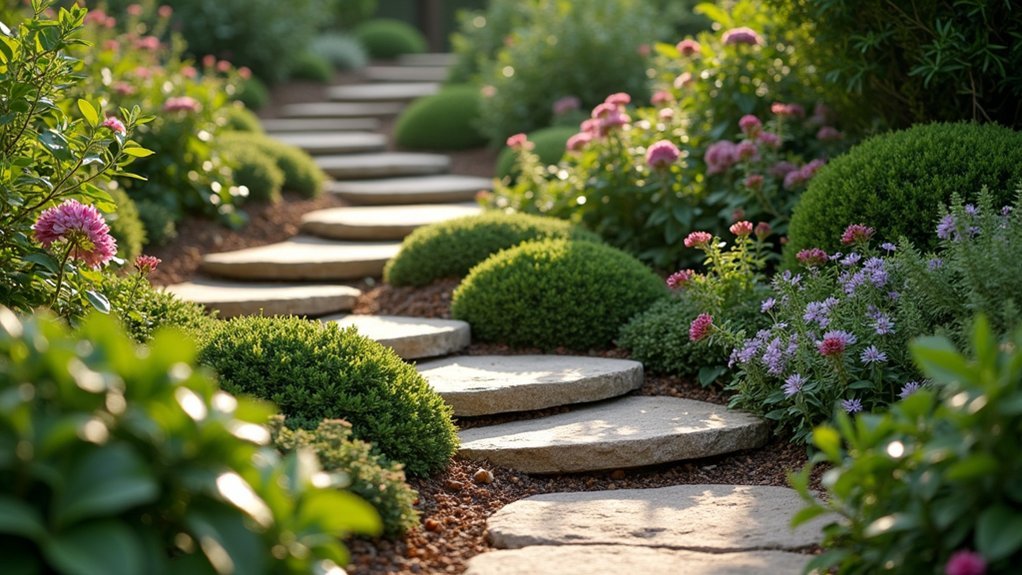
Stone spiral gardens offer far more than decorative appeal—they serve as strategic privacy barriers that simultaneously enhance your property’s security.
Their height and layered structure create natural visual screens between your yard and the outside world.
Stone spiral formations rise like natural sentinels, shielding your personal oasis from prying eyes.
You’ll find that dense plantings within your spiral garden act as effective sound buffers and sight shields, reducing noise from neighbors and blocking unwanted views.
The unique ascending design allows you to position taller plants or stones at key points, limiting access to private areas of your property.
Seasonal Adaptations for Your Stone Spiral Boundary
As seasons shift throughout the year, your spiral boundary can transform from a static structure into a dynamic, ever-changing display that maintains its protective function while showcasing nature’s evolving palette.
By implementing thoughtful seasonal adaptations, you’ll guarantee your stone spiral remains visually striking regardless of weather conditions.
- Color Contrast Strategy – Use differently colored stones alongside plants that bloom in various seasons, creating visual interest that evolves throughout the year while maintaining boundary definition.
- Strategic Plant Selection – Position moisture-loving plants at the bottom of your spiral for wet seasons, with drought-tolerant varieties higher up for summer months.
- Winter Protection Plan – Layer decorative stones or mulch during colder months to protect perennial herbs while preserving your boundary’s aesthetic appeal with minimal maintenance.
Frequently Asked Questions
What Are the Benefits of Herb Spirals?
Herb spirals offer you diverse microclimates in a compact space, improve water efficiency by 20%, provide ideal soil conditions for different herbs, create easy harvest access, and save you money on store-bought produce.
What Is the History of the Herb Spiral?
Herb spirals originated in permaculture design through Geoff Lawton’s work in the early 2000s. You’ll find they’re inspired by natural spiral forms and ancient agricultural practices that maximized growing space and created diverse microclimates.
How Do You Make a Spiral Garden Path?
You’ll create a spiral garden path by outlining the shape with hose or string, clearing debris, adding weed barrier, placing stones from large to small, filling gaps with gravel, and adding decorative plants.
What Is a Spiral Garden?
A spiral garden is a compact, coiled design you can create to maximize growing space. You’ll plant various herbs and flowers in different microclimates created by the spiral’s height and structure using stones or rocks.
In Summary
You’ve discovered how stone spiral gardens can transform your property boundaries into functional, beautiful assets. They’re not just barriers—they’re microclimates, water management systems, and living ecosystems. Whether you’re growing herbs, creating privacy, or simply defining your space, spiral stone gardens offer year-round benefits with minimal maintenance. Take the plunge and watch as your boundary becomes the most distinctive feature of your landscape.





Leave a Reply